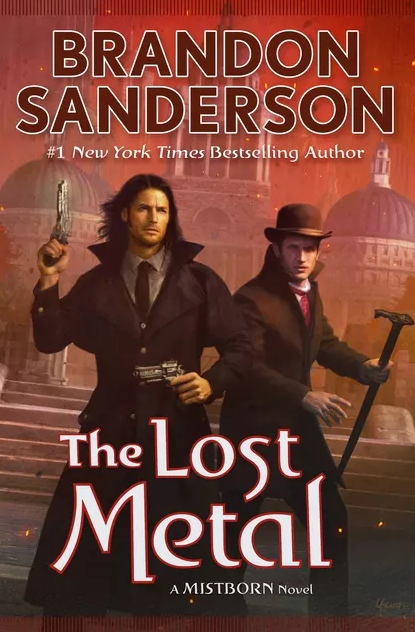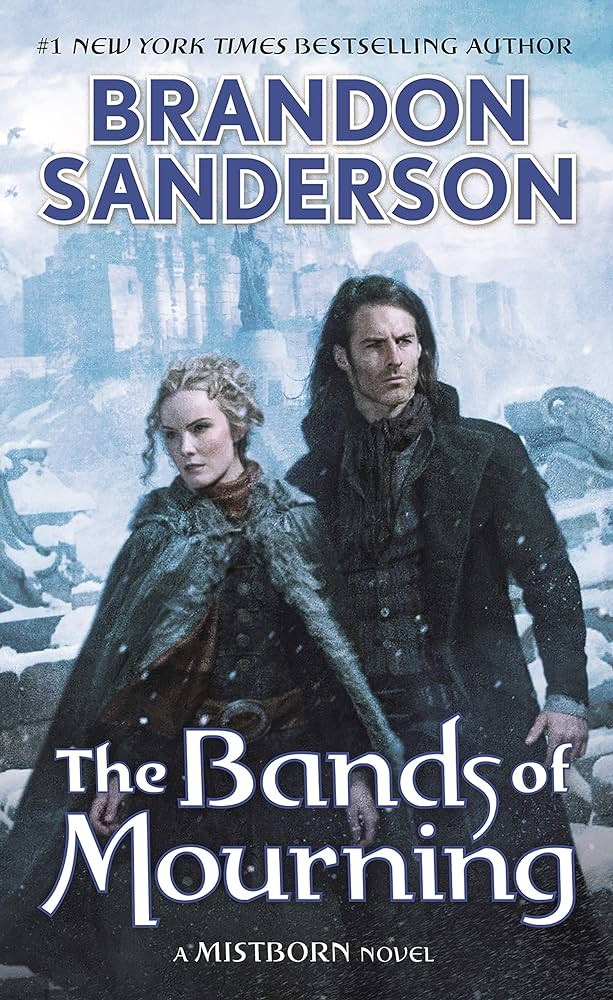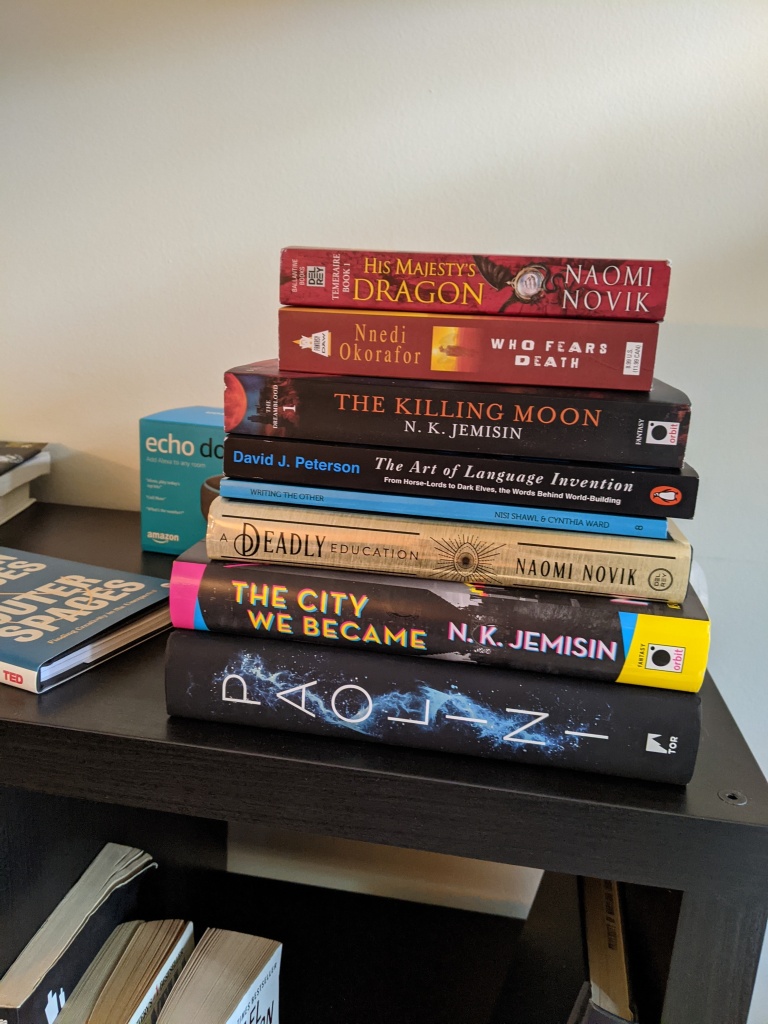No promises, but I think 2024 is the year I FINALLY get caught up on the Cosmere.
According to the QuilToLive: Cosmere Reading Order Guide (which I only chose because it was the easiest list to understand), there are currently (as of this post) 19 ish Cosmere novels?
Even though Brandon Sanderson is one of my favorite authors (and I’ve been reading him religiously since like 2007), I’ve made very few attempts to review his work on this blog. I think the sheer quantity of work has probably held me back.
However, with this review of The Bands of Mourning, I should finally be finished rereading Cosmere books (if not reviewing them), and starting new-to-me Cosmere adventures with The Lost Metal.
Will I finish the last Wax / Wayne book and 3 secret projects in time for the release of the next Stormlight book in December? Only time will tell, but it feels like a good challenge for me to undertake this year.
In any case, I found The Bands of Mourning to be much more interesting in this year of our lord, 2024, than I think I gave it credit for when I originally read it back in April of 2016 (wow I’m feeling old).
Namely, I was not expecting it to feel so dated.
As I mentioned in my review of Alloy of Law, one of the major things I enjoy about this “Era” of Mistborn novels, is the way Sanderson mixes genres to create a unique “alloy”. For AoL, he mixed the Western and Fantasy genres. For Shadows of Self (which I’ve apparently just neglected to review), I feel pretty confident the genres being mixed were Noir and Fantasy.
For The Bands of Mourning?
Old school Pulp Action-Adventure (and of course Fantasy) complete with tomb raiding, a train robbery, and a clandestine enemy base infiltration scene. Of course all of this is made much richer and more interesting through its highly detailed Fantasy setting, as well as easter eggs and call-backs to other books, both Sanderson’s own, and allusions and homage to other authors.
One aspect of Sanderson’s writing that I generally consider a strength, is his ability to take the most well-worn or nearly invisible tropes, and subvert them for dramatic or comedic affect. Without spoilers, the original Mistborn trilogy takes a huge swing at fantasy tropes like The Chosen One, the use of Prophecy within the genre, and the kinds Great Evil / Dark Lord types found in tons of fantasy after Tolkien.
Previous Wax and Wayne outings have also implemented some similarly fun trope deconstruction of the Western and Noir genres, although these were perhaps not as central to the plot as in the original Mistborn and often done for laughs.
This is indeed the tack Sanderson took with The Bands of Mourning taking many shots at the action-adventure genre, archeologist-adventurer stories in general, and probably Indiana Jones in particular. Much of the humor in this book focused around traps, undermining their dramatic effect by rendering them insignificant and ineffectual (perhaps an acknowledgement that real Tomb Defenses are Lame).
These types of subversions are pretty low stakes, easy to read, and probably somewhat timeless. They held up for me on a second read almost a decade removed from the book’s original publication date.
Where the stakes get higher, and for me, a little more dated, was the deconstruction this novel does surrounding gender roles in the action-adventure genre.
I felt these themes were mainly approached through Marasi and Steris’s character development.
Marasi is interesting in that she is not only trying to find her own place in her world (ie the crew, her profession, and society at large), but she is also grappling with her identity as it compares to Vin, the Ascendant Warrior, whose legacy has had a profound effect on gender roles within Elendel.
Some criticism that I’ve seen about the original Mistborn trilogy, is that Vin is the ONLY female character within the cast, and as such, will be seen as a stand in for ALL women. It’s perhaps more eloquently put on the Strong Female Character wikipedia page:
“When these roles are displayed with a small scope of characteristics, it becomes the default expectation for what a woman should be while leaving so many other types of women underrepresented.”
Throughout the original Mistborn trilogy, Vin is one of the most powerful pieces on the chess board. Her combat abilities are, even by in-universe standards, supernatural. Because so much of the action of the story involves her using those abilities, it can be said that her character is still championing traditionally masculine traits. As the lone woman in the story, you don’t need to be a coinshot to make the leap to the idea that women are valuable in stories if they behave like men.
Also, the books have often been called out for their use of the Not Like Other Girls trope which essentially implies a value judgement (better/worse) because the subject does not fit into the normal / accepted confines of “feminine”.
Screen Rant’s 7 Problems A Mistborn Series Could Fix From The Books explains it:
“In addition to lacking female characters, Mistborn tends to put down any women who aren’t Vin — or at least Vin does, and much of the story is told from her perspective. Vin doesn’t trust easily, but she often gives the male characters more slack than the women she meets. In some cases, this is justified; Shan Elariel certainly deserves her scorn. However, Vin judges allies like Tindwyl, and she distrusts Allrianne for all the wrong reasons. It seems anyone with frivolous or feminine tastes meets Vin’s disapproval, even though she spends much of the books grappling with her own desire to embrace such qualities.”
These things are . . . problematic.
Obviously, Sanderson cannot rewrite already published work (or shouldn’t?), but he can acknowledge mistakes when they’re made and try to improve as he writes more books (I personally think this is something which has allowed him to stay not only relevant, but beloved across his MANY books, and decades of his writing). In many ways, I see Marasi’s interiority and character arc as an attempt at engaging with the criticism leveled at the original trilogy.
It seems worth noting here that in The Bands of Mourning, there are two women (gasp) so already we’re making a ‘promising start’ towards righting past wrongs. But does the book manage to break the habits of his earlier work, and all the baggage of the pulpy action adventure genre in general?
I would say results are mixed.
In an attempt to avoid spoilers, I’ll try to remain as vague as possible, but in Marasi’s case, there is a point within the novel in which she has the ability to ‘do the superhero thing’ and really save the day. It’s what she imagines Vin would do (although this is more complicated if you’ve read the original trilogy), and she briefly struggles with this fact, before passing up the opportunity and allowing Wax to fill the role.
Ultimately, it was the logical thing for her arc, and should have felt satisfying because she essentially frees herself from the shackles of Vin’s legacy and the narrow expectations of the society she lives in. However, stepping aside so that a man could save the day did not feel like a win.
I guess I could entertain the argument that the opportunity to do either, the choice, is the true win, but somehow it just doesn’t quite sit with me.
Steris’s arc looks less at past books in the series and more at the action-adventure genre as a whole. Her quest is also one of identity, with the main goal of finding her place within the crew. In one role she serves as a love interest for Wax (and I really do like them as a couple). And in a traditional pulp action adventure story, perhaps this would have been all she wrote.
For Sanderson, this is not enough (so far so good), and he endeavors — much as Steris endeavors — to find some more meaningful place for her within the story. The task is complicated by the fact that Steris does not have allomancy and cannot really fight in the same ways the other characters can (in Alloy of Law, Marasi struggles with something similar: she has allomancy, but the type of power she has is perceived as useless and small spoiler . . . it is not).
Here again we see the emphasis on combat and strength as the traits in the society which are a) masculine, and b) valued. This is no accident as this is exactly the type of world view present in pulp action adventure novels.
The stage is seemingly set for subversion.
And then I’m not really sure how but things seem to fall apart. Perhaps there is simply too many other parts of the plot to resolve? Or we don’t linger on her victory for long enough? Something else?
Steris (again as best I can without spoilers) does use her unique skill set (her overpreparedness) to resolve an issue in the resolution, and Wax does marry her in earnest (this book opens and closes with weddings) . . . her most memorable scene in the story is still somehow the one in which she literally compares herself to a piece of luggage.
And perhaps that is unfortunately what makes her arc feel so unsatisfying and not a subversion of the tropes discussed above. Despite the fact that all of the pieces are “technically” there, it still feels like she’s carried through the story. Window dressing. Someone which will generate a laugh when needed or stir emotion in our dark and brooding hero, but other than that, just another tool for the author.
Which ends up being kinda brutal, because she is truly a great character.
My final complaint about The Bands of Mourning, is that I’m starting to tire a bit on Wayne. There is a storytelling trap which writers can fall into, described in Brandon Sanderson’s own writing podcast (Writing Excuses), called Flanderizing. It was coined for The Simpsons character, Flanders, who assumedly (I haven’t watched a ton of Simpsons) became more and more 1-dimensional over time as the writers focused on his quirks, and less on interesting character development. Flanders essentially became a button the writers could press when they could feel the show should have a laugh, but there was no organic humor present.
It feels like this is what is happening to Wayne throughout The Bands of Mourning, which only gets compounded by the fact that Sanderson routinely uses the same rhetorical device, malapropism, in Wayne’s humor. I think Sanderson could feel this happening while writing Bands, and Wayne’s character takes on some more interesting shades of gray LATE in the novel, but ultimately if felt like too little too late.
Give This One A Read?
Though I’ve written A LOT of words in this post which present it unfavorably, I did enjoy the book and would certainly recommend it. The parts I enjoyed most were perhaps the easiest parts: the action, magic, humor and adventure we expect from a Brandon Sanderson novel.
The criticism I have of the book is primarily focused on its larger themes which were ambitious, and well intentioned, but ultimately felt unsatisfying. In regards to these larger themes, I found myself often wondering why The Bands of Mourning was the right book for exploring them, and why Sanderson the right author to do so.
All that said, I’m still chomping at the bit to start The Lost Metal. The flaws I’ve described above only seem to infuse this final outing with even MORE potential.
That’s all I have for this week. What are your thoughts? Have any of you read this one before? What were your favorite parts? Your least favorite? Let me know in the comments.
See you next time!










